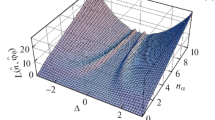Summary
The superposition of two partially coherent but completely polarised beams is discussed. The formula for the intensity of the resultant beam is obtained from the interference formula for coherent beams by multiplying the third interference term by the degree of coherence γ (defined statistically). The states of the two given polarised beams and that of the resultant incompletely polarised beam may be characterised by respective vectors drawn from the centre of the Poincaré sphere : the length of each vector and its orientation (i.e., point of intersection with the sphere) may be regarded as giving respectively the intensity and state of polarisation, of the polarised fraction of the corresponding beam. The vector for the resultant beam is obtained by adding to the sum of the two given vectors (which are directed towards points A and B), a third vector directed towards a point C″ on the Poincaré sphere. This last vector which arises because of the interference of the beams, is specified in terms of the angles of the triangle ABC″, which is isoscles: the base angles A and B are both equal to the effective phase difference δ and the length of the vector is equal to\(2\gamma \sqrt {I_1 I_2 } \sin \raise.5ex\hbox{$\scriptstyle 1$}\kern-.1em/ \kern-.15em\lower.25ex\hbox{$\scriptstyle 2$} \hat C''\).
The converse problem is discussed and also the addition ofn partially oherent polarised beams. The paper also presents the subject of the Stokes parameters of partially polarised radiation through an extension of the Poincaré representation.
Similar content being viewed by others
References
handrasekhar, S.Radiative Transfer, 1949, Oxford.
Fano, U.J. Opt. Soc., 1949,39, 859.
Hurwitz, H.J. Opt. Soc. Am., 1945,32, 525.
Linfoot, E. H.Recent Advances in Optics, 1955, Oxford.
Pancharatnam, S.Proc. Ind. Acad. Sci., 1956,54 A, 247.
Ramachandran, G. N.J. Madras Univ., 1952,22 B, 277.
RayleighScientific Papers, Cambridge, 1902,3, 140.
Stokes, G. G.Mathematical and Physical Papers, Cambridge, 1901,3, 233.
Zernike, F.Physica, 1938,5, 785.
Author information
Authors and Affiliations
Additional information
Communicated by Sir C. V. Raman
Rights and permissions
About this article
Cite this article
Pancharatnam, S. Generalized theory of interference and its applications. Proc. Indian Acad. Sci. 44, 398–417 (1956). https://doi.org/10.1007/BF03046095
Received:
Issue Date:
DOI: https://doi.org/10.1007/BF03046095




